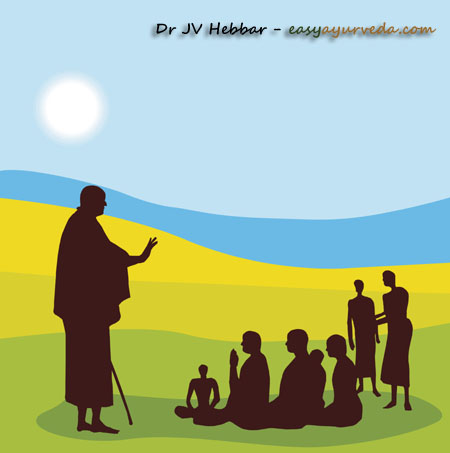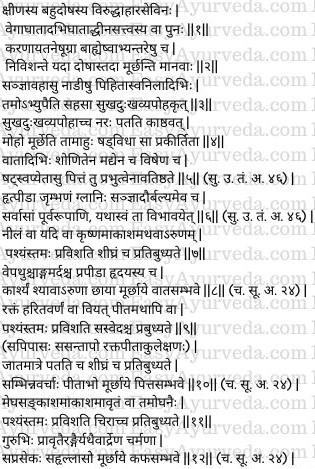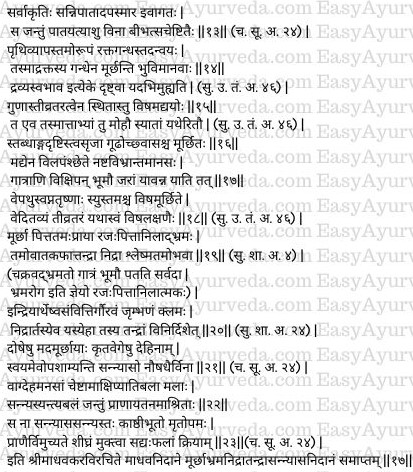Madhava Nidana Chapter 17 Murcha Bhrama Nidra Tandra Sanyasa Nidanam
This article explains Madava nidana 17th chapter “Murcha Bhrama Nidra Tandra Sanyasa Nidanam”. Causes, pathology and symptoms of Murcha, Bhrama, Nidra, Tandra and Sanyasa are explained in this chapter.
Read – Acharya Madhavakara: His Work ‘Madhava Nidana’, Legacy, Amazing Facts

Table of Contents
Nidana and Samprapti of Murcha
Nidana: Casues of murcha – The aggravated doshas cause murcha – fainting in persons who are emaciated (debilitated), in whom the doshas have undergone profound increase, those who indulge in incompatible foods and suppression of urges, those who are injured and those who are mentally weak.
Samprapti: Due to the above said factors the doshas undergo severe aggravation. These doshas get entry into and lodged in the external and internal organs related to the mind and cause the disease murcha – fainting. (1-2)
How does murcha develop? – extended pathogenesis & types of murcha
When the sajnavaha srotas (channels that carry sensations) are blocked by the increased vata and other doshas, the person experiences darkness in front of his eyes (goes into deep darkness). Due to this, the person will not be able to differentiate between pleasure and pain. He falls on the ground like a dry log of wood and becomes unconscious.
This condition is known as moha or murcha.
Read – Srotas: Body Channels and Duct systems – Easy Explanation
Types of Murcha
Murcha is of 6 kinds, one from each dosha, one from rakta (blood), one from madya (alcoholic beverages), and another from visa (poisons). Pitta will be the predominant dosha in all these types of murcha. (3-5)
Murcha Purvarupa
Premonitory symptoms of fainting
The premonitory symptoms of all types of murcha are – pain in the heart, excessive yawning, and weakness, improper or inadequate knowledge (inability of sense organs to perceive their respective sense objects leading to inadequate knowledge of things around us). These are the general premonitory symptoms of all types of murcha. Along with this the premonitory symptoms of the other types of murcha shall be understood by seeing the presence of their symptoms along with these general symptoms.
Example – if along with these premonitory symptoms, the symptoms of vataja type of murcha are present, they shall be considered as the premonitory symptoms of vataja murcha. (6)
Read – Dizziness: Causes, Symptoms, Ayurvedic Remedies, Treatment
Symptoms
Vataja Murcha Symptoms
In vataja murcha – while fainting (going into unconsciousness) the person sees the sky (or his surroundings) in blue, black or crimson colours, goes into darkness (experiences darkness in front of his eyes), falls down unconscious but regains consciousness quickly. He would also have tremors, pain all over the body, and severe pain in the heart, emaciation, blackish red discoloration of the body. (7-8)
Pittaja Murcha Symptoms
In pittaja murcha – while fainting (going into unconsciousness), the person sees the sky and surroundings in red, green or yellow colours. The person faints and goes into unconsciousness and would sweat a lot when he regains consciousness (gains consciousness along with sweating). (In this stage the person would experience thirst, increase in temperature of the body, red or yellow colour of the eyes, would go into a state of unconsciousness along with these symptoms and quickly regain consciousness). Diarrhoea and yellowish discolouration of the body are the other symptoms of pittaja type of murcha. (9-10)
Read – Pitta Increase Symptoms – Pitta Vriddhi Lakshana
Kaphaja Murcha Symptoms
In kaphaja mūrchā – while fainting (going into unconsciousness), the person sees the sky covered with thick clouds, falls unconscious. In this condition, the person regains consciousness after a long time. He feels as though his body is covered with heavy moist leather. Excessive salivation and nausea are the other symptoms of kaphaja type of murcha. (11-12)
Read – Kapha Increase Symptoms – Kapha Vruddhi Lakshana
Sannipataja Murcha Symptoms
In sannipātaja type (caused by all the doșhas together) there will be manifestation of all the symptoms (of all the doshas) together. Leaving out ‘bibhatsa chesta – disgusting or loathsome activities’ the person would have all the other symptoms of apasmara disease (epilepsy, memory disorders). The bouts of fainting will be similar to those seen or experienced in apasmara. In this condition the person will faint (go into a state of unconsciousness) very quickly. (13)
Bibhatsa Cesta – Froth coming out of the mouth, grinding of teeth, rolling of eyes, hallucinations and convulsions are known as bibhatsa cesta and are invariably seen in apasmaara (epilepsy).
Read – Apasmara Meaning And Understanding
Raktaja Murcha Symptoms
The prthvi and ap bhutas (earth and water elements) are predominant in tamo guna. The smell of blood is also predominant in prthvi and ap bhutas and hence predominant in tamo guna (the disease murcha is also predominant in tamo guna).
This is the reason that some persons who are predominant in tamo guna (in their constitution) become unconscious and faint, falling to the ground when they smell (and also sight) the blood. Some consider this to be the specific property of the blood. (14)
Visha-Madhyaja Murcha Symptoms
The properties (qualities) of poison and alcoholic drinks are very intense / sharp and damaging in comparison to any other things having intense / sharp quality. Therefore, the vishaja and madhyaja murcha are produced due to the effect of these qualities. In murcha caused by poisons and alcoholic drinks the symptoms are very profound.
Read – Rakta Pradoshaja Rogas – When Blood Is Vitiated By Doshas
Raktaja Murcha
Raktaja Murcha – In raktaja murcha stiffness of the body, fixed gaze and deep (difficult) breathing – severe dyspnoea is seen.
Madyaja Murcha
Madyaja (alcoholic) Murcha – In Madyaja Murcha inconsistent (irrelevant) speech (delirium), falling on the ground with loss of consciousness and mental activities are seen. The person makes in-coordinated movements of the body parts (throwing of hands and feets), falls unconscious and stays in that state until the alcohol is digested in the body. (This means to tell that the symptoms of this type of murcha disappear once the alcohol gets digested).
Read – Charaka Madatyaya Chikitsa 24th Chapter – Alcoholism
Vishaja Murcha
Vishaja (due to poison) Murcha – In Visaja Murcha there are tremors (rigors), sleep, thirst and feeling of darkness (in front of the eyes). Apart from this, the other symptoms specific to the particular (specific) poisons too will be present. The symptoms will be specific to the poison and can be mild, severe or harmful depending on the sharpness and intensity of the poison involved. (15-18)

Dosha predominance
Dosha predominance in murcha, bhrama, tandra and nidra
- Mürcha (fainting, unconsciousness) is caused by predominance of pitta and tamas.
- Bhrama (giddiness) is caused by predominance of rajas, pitta and vata.
- Tandra (stupor) is caused by predominance of tamas, vata and kapha.
- Nidra (sleep) is caused by predominance of kapha and tamas. (19)
Read – Satva, Rajas, Tamas as per Ayurveda
Bhrama
The body reeling like a turning (spinning) wheel and the person falling on the ground (repeatedly) always is known as bhrama roga (giddiness). It is caused due to predominance of rajas, pitta and vata.
Tandra
The symptoms of tandra (stupor) include – non-perception of the sense objects by their related sense organs, feeling of heaviness (of the body), excessive yawning, weakness / fatigue (even without physical work) and the person appearing as though sleeping. (20)

Mada, Murcha Sanyasa – Difference
In cases of mada and all types of mürcha, etc. the person recovers soon after the bouts produced by doshas are over and even without medicines. On the other hand, sanyasa (another similar disease – compared to coma) does not subside without appropriate treatment. (21)
Read – Relationship between Tamas and Sleep: Tamobhava Nidra
Sanyasa
The doshas which have become very powerful invade the chief seat of prana and obstruct the functions of speech, body and mind and makes a debilitated person unconscious and fall on the ground. This condition is known as sanyasa (coma). In this condition the person falls down on the ground like a dry log of wood or like a dead person. If this condition is not addressed immediately and if proper and quick restorative treatment is not given the person will surely die. (22-23)
Thus ends the chapter on Murchā Nidanam in Madhava Nidana text written by Acharya Madhavakara.











